Top Rankings
Fairland Local School District ranks among the top 20% of public school district in Ohio for:
Category
Attribute
Graduation Rate
Highest graduation rate (Top 10%)
For the 2025 school year, there are 4 public schools serving 1,376 students in Fairland Local School District. This district's average testing ranking is 8/10, which is in the top 30% of public schools in Ohio.
Public Schools in Fairland Local School District have an average math proficiency score of 62% (versus the Ohio public school average of 52%), and reading proficiency score of 70% (versus the 60% statewide average).
Minority enrollment is 6% of the student body (majority Black and Hispanic), which is less than the Ohio public school average of 34% (majority Black).
Overview
This School District
This State (OH)
# Schools
4 Schools
3,572 Schools
# Students
1,376 Students
1,670,552 Students
# Teachers
79 Teachers
96,800 Teachers
Student : Teacher Ratio
17:1
17:1
District Rank
Fairland Local School District, which is ranked within the top 30% of all 918 school districts in Ohio (based off of combined math and reading proficiency testing data) for the 2021-2022 school year.
The school district's graduation rate of 95% has stayed relatively flat over five school years.
Overall District Rank
#237 out of 929 school districts
(Top 30%)
(Top 30%)
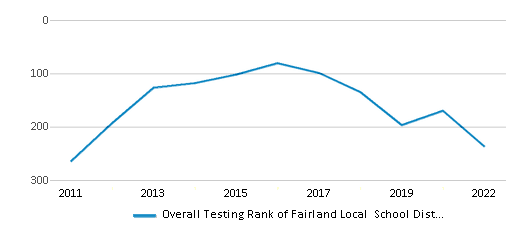
Math Test Scores (% Proficient)
62%
52%
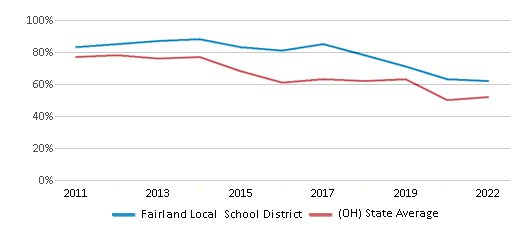
Reading/Language Arts Test Scores (% Proficient)
71%
60%
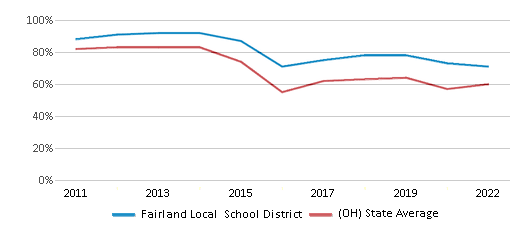
Science Test Scores (% Proficient)
60%
63%
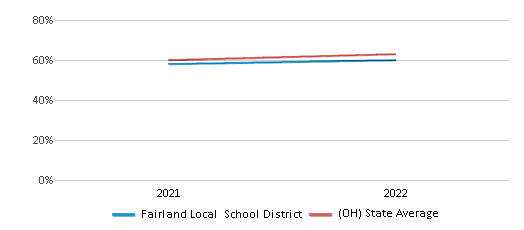
Graduation Rate
≥95%
86%
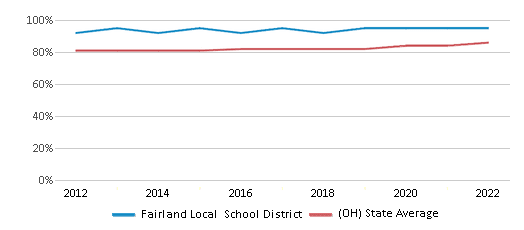
Students by Ethnicity:
Diversity Score
0.12
0.53
# American Indian Students
n/a
2,370 Students
% American Indian Students
n/a
n/a
# Asian Students
8 Students
49,192 Students
% Asian Students
n/a
3%
# Hispanic Students
9 Students
130,270 Students
% Hispanic Students
1%
8%
# Black Students
17 Students
283,872 Students
% Black Students
1%
17%
# White Students
1,291 Students
1,098,036 Students
% White Students
94%
66%
# Hawaiian Students
n/a
1,718 Students
% Hawaiian Students
n/a
n/a
# Two or more races Students
51 Students
105,080 Students
% of Two or more races Students
4%
6%
Students by Grade:
# Students in PK Grade:
44
46,438
# Students in K Grade:
94
117,523
# Students in 1st Grade:
95
119,240
# Students in 2nd Grade:
108
123,668
# Students in 3rd Grade:
104
116,979
# Students in 4th Grade:
101
120,578
# Students in 5th Grade:
119
121,564
# Students in 6th Grade:
125
121,429
# Students in 7th Grade:
97
123,631
# Students in 8th Grade:
117
124,479
# Students in 9th Grade:
107
136,464
# Students in 10th Grade:
109
133,227
# Students in 11th Grade:
77
135,708
# Students in 12th Grade:
79
129,624
# Ungraded Students:
-
-
District Revenue and Spending
The revenue/student of $12,073 in this school district is less than the state median of $17,287. The school district revenue/student has stayed relatively flat over four school years.
The school district's spending/student of $11,140 is less than the state median of $17,235. The school district spending/student has stayed relatively flat over four school years.
Total Revenue
$17 MM
$28,879 MM
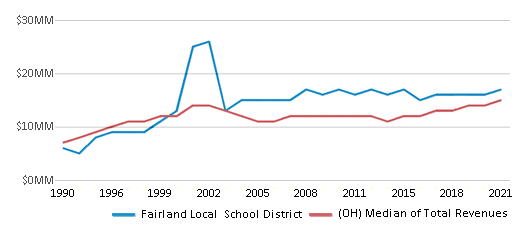
Spending
$15 MM
$28,792 MM
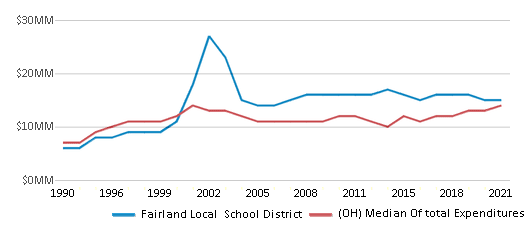
Revenue / Student
$12,073
$17,287
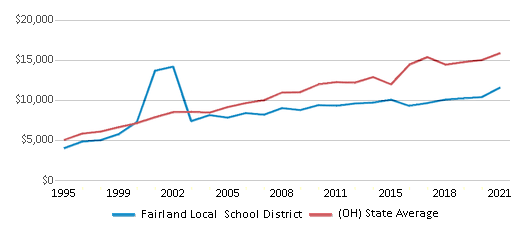
Spending / Student
$11,140
$17,235
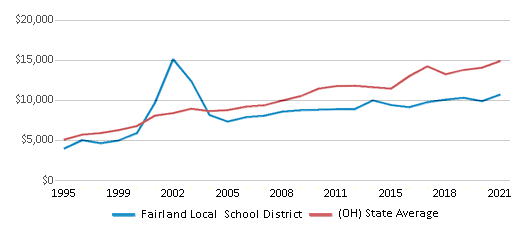
Best Fairland Local School District Public Schools (2025)
School
(Math and Reading Proficiency)
(Math and Reading Proficiency)
Location
Grades
Students
Rank: #11.
Fairland West Elementary School
(Math: 78% | Reading: 76%)
Rank:
Rank:
9/
Top 20%10
110 Township Road 1125
Proctorville, OH 45669
(740) 886-3150
Proctorville, OH 45669
(740) 886-3150
Grades: 3-5
| 324 students
Rank: #22.
Fairland Middle School
(Math: 58% | Reading: 68%)
Rank:
Rank:
7/
Top 50%10
7875 County Road 107
Proctorville, OH 45669
(740) 886-3200
Proctorville, OH 45669
(740) 886-3200
Grades: 6-8
| 339 students
Rank: #33.
Fairland High School
(Math: 30-34% | Reading: 60-64%)
Rank:
Rank:
4/
Bottom 50%10
812 County Road 411
Proctorville, OH 45669
(740) 886-3250
Proctorville, OH 45669
(740) 886-3250
Grades: 9-12
| 372 students
Rank: n/an/a
10732 County Road 107
Proctorville, OH 45669
(740) 886-3120
Proctorville, OH 45669
(740) 886-3120
Grades: PK-2
| 341 students
Frequently Asked Questions
How many schools belong to Fairland Local School District?
Fairland Local School District manages 4 public schools serving 1,376 students.
What is the rank of Fairland Local School District?
Fairland Local School District is ranked #241 out of 918 school districts in Ohio (top 30%) based off of combined math and reading proficiency testing data for the 2021-2022 school year. This district ranks in the top 20% of Ohio school districts for: Highest graduation rate (Top 10%)
What is the racial composition of students in Fairland Local School District?
94% of Fairland Local School District students are White, 4% of students are Two or more races, 1% of students are Hispanic, and 1% of students are Black.
What is the student/teacher ratio of Fairland Local School District?
Fairland Local School District has a student/teacher ratio of 17:1, which is equal to the Ohio state average of 17:1.
What is Fairland Local School District's spending/student ratio?
The school district's spending/student of $11,140 is less than the state median of $17,235. The school district spending/student has stayed relatively flat over four school years.
Recent Articles

Year-Round Or Traditional Schedule?
Which is more appropriate for your child? A year-round attendance schedule or traditional schedule? We look at the pros and cons.

Why You Should Encourage Your Child to Join a Sports Team
Participating in team sports has a great many benefits for children, there is no doubt. In this article you will learn what those benefits are.

White Students are Now the Minority in U.S. Public Schools
Increasing birth rates among immigrant families from Asia and Central and South America, combined with lower birth rates among white families, means that for the first time in history, public school students in the United States are majority-minority. This shift in demographics poses difficulties for schools as they work to accommodate children of varying language abilities and socio-economic backgrounds.





